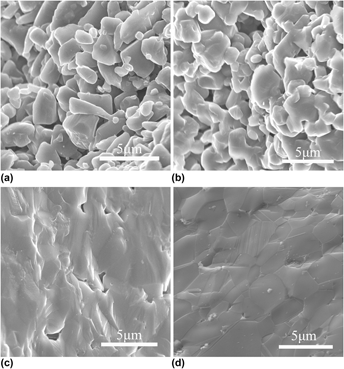Crossref Citations
This article has been cited by the following publications. This list is generated based on data provided by
Crossref.
Nisar, Ambreen
Ariharan, S.
and
Balani, Kantesh
2018.
Densification kinetics and mechanical properties of tantalum carbide.
International Journal of Refractory Metals and Hard Materials,
Vol. 73,
Issue. ,
p.
221.
Chen, Huan
Zeng, Fanhao
Li, Wenjie
Liu, Ji'an
Gu, Yi
and
Zhang, Fuqin
2019.
Densification behavior and mechanical properties of spark plasma reaction sintered ZrB2–ZrC-B4C ceramics from B4C-Zr system.
Ceramics International,
Vol. 45,
Issue. 9,
p.
12122.
Dutka, V. A.
Maystrenko, A. L.
and
Kulich, V. G.
2019.
The Effect of Design Parameters of a Production Unit on the Temperature Drop in a Sample During High-Speed Sintering under Pressure.
Journal of Superhard Materials,
Vol. 41,
Issue. 6,
p.
421.
Dutka, V. A.
Maystrenko, A. L.
Borymskyi, O. I.
Kulich, V. G.
and
Kosenchuk, T. O.
2020.
Modeling the Temperature Field in a High-Pressure Apparatus during the Sintering of Large-Sized Products Based on Boron Carbide.
Journal of Superhard Materials,
Vol. 42,
Issue. 4,
p.
240.
Li, Wenjie
Zeng, Fanhao
Li, Lei
Wang, Ziwei
Liu, Honghao
Peng, Yirui
and
Gu, Yi
2020.
Spark plasma sintering of Ti–1Al–8V–5Fe alloy: densification mechanism and grain growth.
Applied Physics A,
Vol. 126,
Issue. 9,
Chen, Huan
Zeng, Fanhao
Li, Wenjie
Li, Lei
Wang, Ziwei
Liu, Honghao
Peng, Yirui
Gu, Yi
and
Zhang, Fuqin
2020.
Effect of interfacial residual thermal stress on the fracture behavior of Cf/B4C composites prepared by spark plasma sintering.
Ceramics International,
Vol. 46,
Issue. 4,
p.
4587.
Diatta, Joseph
Torresani, Elisa
Maximenko, Andrey
Haines, Chris
Martin, Darold
and
Olevsky, Eugene
2021.
Peltier effect during spark plasma sintering of boron carbide.
Results in Physics,
Vol. 29,
Issue. ,
p.
104719.
Bai, Wenhui
Liu, Wei
Wang, Weimin
Peng, Chao
Wang, Aiyang
He, Qianglong
Liu, Geng
and
Huang, Shangyu
2021.
Drucker-Prager-Cap modelling of boron carbide powder for coupled electrical-thermal-mechanical finite element simulation of spark plasma sintering.
Ceramics International,
Vol. 47,
Issue. 15,
p.
21536.
Xuan, Weiping
Ji, Yuchun
Liu, Bingsai
Li, Shaofei
Chen, Wenzhuo
Li, Zhengdei
Wang, Jilin
Zheng, Guoyuan
and
Long, Fei
2023.
Spark plasma sintering of boron nitride micron tubes reinforced boron carbide ceramics with excellent mechanical property.
International Journal of Applied Ceramic Technology,
Vol. 20,
Issue. 3,
p.
1457.






